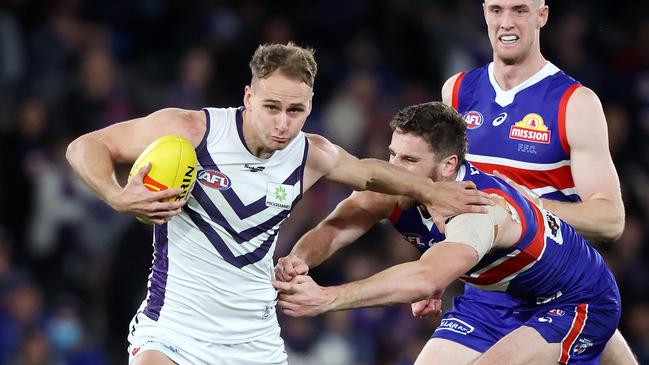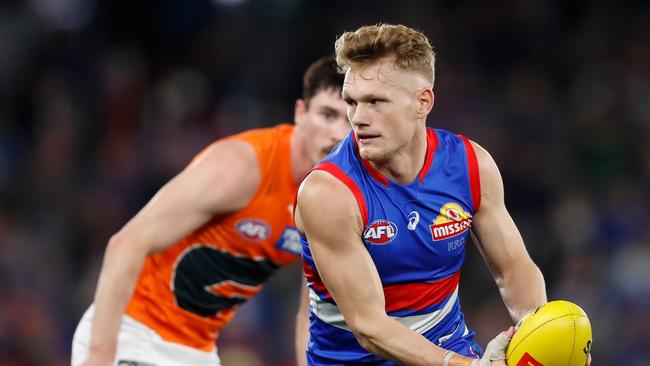AFL Rich 100: How salary cap is influencing trade, contract decisions
The days of paying anything to retain star players seems to be gone with clubs not willing to break the bank on players who ‘want out’.
AFL
Don't miss out on the headlines from AFL. Followed categories will be added to My News.
Player departures were once seen as a disaster in club land.
When rival clubs come for star players or gun up-and-comers, we’ve often seen teams go over and above to keep their men.
No one wants the disruption or negative headlines when big names walk out.
Brodie Grundy got great money to stay at Collingwood, Crow Rory Sloane was handsomely rewarded for turning down Victorian interest and Jeremy McGovern and Andrew Gaff signed whopping deals at West Coast.
All to remain.
For years, GWS bent over backwards to keep its superstar midfielders on eye-watering contracts.
But perhaps the list management tide has turned somewhat.
When it comes to the art of salary cap management, there seems an increasing appetite – or at least more of an open-mindedness – to let players go to chase the big bucks elsewhere.
The question clubs face isn’t always straightforward.

Do you compromise your cap to keep the player at all costs? Or draw a line and say goodbye?
What we have seen this year is Collingwood not fall over itself to re-sign Jordan De Goey.
The Sydney Swans didn’t blink on Lance Franklin and Melbourne won’t pay the world to keep Luke Jackson when it has plenty of other superstar mouths to feed.
Port won’t match Hawthorn’s bid for Karl Amon and Brisbane looks set to release Daniel McStay amid conjecture about both of their price tags.
Perhaps Fremantle’s list management crew, led by David Walls, set the trend in a sense last year when Carlton came hard for midfielder Adam Cerra.
Fremantle could have offered the 22-year-old a godfather deal to keep him alongside Andrew Brayshaw.
But four years after letting Lachie Weller go for pick 2 (the Brayshaw pick) to Gold Coast, Fremantle last year parted ways with Cerra and found a bargain-basement replacement from Gold Coast in Will Brodie.
Brodie, who has racked up the most clearances and most centre clearances at the Dockers at round 21, is one of the top pick-ups of the year alongside Tyson Stengle and Mabior Chol.
The beauty in the Brodie deal was two-fold.
Not only did the Dockers pay relative peanuts for the hard nut – giving it the salary cap space to have a crack at Melbourne’s Luke Jackson and Richmond’s Liam Baker (who recently re-signed with the Tigers) – but Fremantle may also have struck the trade deal of the year.
Fremantle received Brodie, and pick 19 from the Suns in exchange for a future-second and fourth-round picks.
The Suns were tight on their cap and didn’t think Brodie would play ahead of Touk Miller or Matt Rowell in the middle this year.
But for Fremantle, it nabbed a clearance machine in Brodie, secured slick Western Australian midfielder Matthew Johnson with pick 19 and, in the end, didn’t pay overs for Cerra.

Fremantle chief executive Simon Garlick said the situation “might turn out quite good for us” even as the club assembles a mammoth offer for Jackson one year later.
“I think clubs can get obsessive about maintaining a player at all costs,” Garlick said.
“I don’t know if sometimes that is based upon not wanting to be seen as a club that loses a player here and there.
“If someone wants out, I think there is an element of objectivity where you sit there and say, ‘OK, that is fine, how do we maximise this situation?’, rather than potentially compromising where you’re going in the longer term or missing out on an opportunity.”
Perhaps Melbourne has a similar view in regards to Jackson.
Previously, trades were largely marked on the players and picks which swapped hands. And everyone wants to be seen as the winner in the deal. The more first-round picks, the better in trade wars.
But what has become an increasingly important factor is the salary cap ramifications. And in particular, value for money. Repeatedly paying overs is an easy trap to fall into when it leaves clubs jammed up with no space.
And no club felt the crunch more than Collingwood in 2020 when it let go Adam Treloar and Jaidyn Stephenson for not much in return in terms of picks.

Treloar was on $900,000, Grundy $950,000 and with all the back-ended deals, Collingwood saw the asteroid hurtling straight toward in it when it decided to pull off a near $2 million salary dump.
But those big calls provided the launch pad to nab midfielder Patrick Lipinski and versatile tall Nathan Krueger last year, and McStay this year.
Grundy’s departure could also clear the way for the Pies to sign goalkicking GWS midfielder Tim Taranto.
The 2020 trade period may have, in part, cost Nathan Buckley his senior coaching job, but there are few Collingwood supporters who would be unhappy with the club’s extraordinary trajectory just two years later under Craig McRae.
Greater Western Sydney is in the same boat as the Magpies in 2020, as the Giants prepare to clear another $1 million in salary cap room as part of another rolled-gold salary sump.
In what will be one of the biggest stories of this year’s trade period, the Giants are again maxed out after signing jet playmakers Josh Kelly, Stephen Coniglio and Lachie Whitfield on near $1 million a year contracts.
Even Nick Haynes’ contract is worth north of $800,000 next year.
Clearly, rival clubs had the Giants over a barrel when they came hard for those players. Blank cheques were thrown around everywhere.
The problem now is the Giants are at their limit, meaning star midfielders Taranto and Jacob Hopper are both vulnerable. Whitfield isn’t off-limits, either. Bobby Hill and Tanner Bruhn also want out.
So the Giants are throwing the lifeboats overboard in a bid to recalibrate.
But in this AFL merry-go-round, there is also opportunity.
For every club under cap intense salary cap pressure, there is a rival on the hunt. Some clubs this year have room. But who will be active and aggressive?
Fremantle has cash to splash on Jackson at about $800,000-plus over six years, while it also had money put aside for Tigers’ Baker as part of a sneak attack.
Essendon is another with some disposable income after losing Joe Daniher, Adam Saad and Orazio Fantasia.

The Bombers had enough coin banked to have a decent go at Ben King, Izak Rankine, Angus Brayshaw and Liam Jones over the past 12 months.
North Melbourne has banked plenty of money in recent years to bring in some mature talent and even Geelong has saved up a piggy bank to bolster the midfield.
The Cats have had their eye on Hopper, the tough nut onballer from Ballarat, ever since GWS played hard ball on Jeremy Cameron, and decided to match the Cats’ free agency bid.
Geelong has a plan to thicken the midfield with Joel Selwood nearing the end of his champion career.
And Adelaide, which will be under the pump to climb the ladder next year, has drummed up the kind of offer Rankine can’t refuse. More than $4 million over five years for a third-year forward pocket is huge.
The Suns, as has been the recent trend, won’t stump up the same coin. That’s how their salary cap blew up last time, paying highly-talented top draft picks more money than they probably deserved to stay north.
But the Suns have retained some of their most important players and now can be more restrained when it comes to re-signings.
Clearly, the purse strings have been tightened somewhat across the league.
And when it comes to contract management, few clubs have a flatter (or more modest) pay structure for its existing stars than the Cats.
Salary sacrifice rules in “Sleepy Hollow”.
All contracts are responsible, and reasonable under list bosses Stephen Wells and Andrew Mackie.
The big bucks have gone to the four big dogs in Selwood, Tom Hawkins, Patrick Dangerfield and Jeremy Cameron, but even Selwood and Hawkins took much less to help sign Cameron.
This is the same club, of course, which is sitting pretty as the team to beat for this year’s flag.


